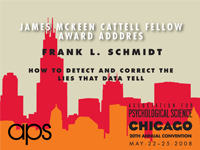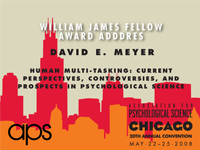Nature and Nurture as Allies
In the APS Convention program on “Genetics, Environment, Culture, and Behavior,” one message was made clear: Research has revealed that nature and nurture are no longer enemies, but instead, they are allies.
“For a gene to spring into action, for it to have an impact on your biology, you need something to essentially ‘turn on’ this gene,” said Steve Cole, University of California, Los Angeles, in his address on “Social Regulation of Gene Expression.”
“If you take the human genome and put it in a little tube, it’s going to sit there and do nothing,” he continued. “So clearly, DNA by itself really isn’t sufficient to structure much of existence at all.”
So then, what genes are being activated out of the 22,000 genes with the ability to do so, asked Cole, and more importantly, why? Or stated more broadly, how do environmental factors affect human biology?
In order for the environment to have an impact on someone’s genetic makeup, there need to be outside factors that produce some sort of physiological response, “some kind of chemical messenger — like a neurotransmitter, a cytokine, perhaps a hormone — that comes into the vicinity of the cell and binds to a receptor,” said Cole. “And those receptors, in turn, are what are responsible for triggering the activity of these transcription factors.”
Cole used the example of an observational study with John Cacioppo, immediate past APS President, in which they examined leukocytes, cells in the human immune system, in individuals considered to be particularly lonely. What Cole and Cacioppo found is solid evidence supporting the direct impact of social factors on gene transcription: Certain genes in the lonely individuals were far more expressed than those in the control group.
So the environment does, in fact, seem to play an important role in gene transcription, but which particular pathways are especially sensitive to social factors? According to Cole, the self-proclaimed “psychologist gone awry,” “[Biologists] don’t spend a lot of time asking ‘why is the cytokine active,’ ‘why is this neurotransmitter here?’ But, of course, this is our recipe for connecting the biology of genes to this social environment or psychological process.”
Cole provided evidence of a “stress niche” through his research on social and environmental influences on the progression of HIV. The results indicated that HIV-positive individuals who were shy and introverted showed more rapid disease progression — at about a 20 to 30 percent acceleration rate — than did those who were socially outgoing.
“Almost every really successful viral pathogen, it turns out, is sensitive to human stress biology, and that is extremely unlikely to occur by chance,” he revealed to the audience. “It appears much more probable that there is a stress niche in the genome of humans that is a good place for viruses to evolve into.”
It appears, therefore, that the line between nature and nurture is blurred as humans’ genetic makeup is forever adapting to centuries of existence and even changing to accommodate for our own immediate lifetimes. As Cole aptly put it, “the experience I have now will change the transcription of my genes later.”
Hand-Me-Down Genes
But aren’t we born with the genetic code we will always have? Although Cole believes an individual’s genetic makeup can change according to his or her experiences, Brian D’Onofrio from Indiana University discussed the importance of considering genetic factors passed down from parents to offspring when studying environmental risk factors. In his invited talk “What Can Behavior Genetics Tell Us About the Family Environment (If Anything)?” D’Onofrio explored the current assumptions about and recent progression of behavior genetics.
“When I talk to developmental psychologists and ask them, ‘What do you think behavioral genetics tells us about the family environment?’” D’Onofrio said, “this is the typical reaction I get: ‘the environment doesn’t matter’ or ‘the family environment doesn’t matter’ or ‘parents don’t matter.’”
D’Onofrio set out to disprove the notion that behavior genetics research doesn’t consider developmental issues and doesn’t test mechanisms, and even that behavior genetics samples are too small and specific to generalize. To do so, he referenced several studies to support “the nature of nurture,” or the role of genetics in family risk factors.
One such study by Sara R. Jaffe, University of Pennsylvania, analyzed the exposure to spanking and researched the relationship between parenting and conduct problems in twins. According to D’Onofrio, the results indicate that there is no “gene for getting spanked” but rather a tendency for children’s behaviors, which are genetically influenced, to illicit corporal punishment. Therefore, having passed-down genetic risk for antisocial behavior doesn’t guarantee a child will get spanked, but it may increase the likelihood.
“If you want to understand the role of putative environmental risk factors, such as sleep deprivation, you need to consider that environments do not have an ‘at-random,’” explained D’Onofrio. “As an assistant professor with two young children, sleep deprivation [for example] does not happen at random. And we need to understand that nonrandom selection into the environment if we want to understand the effects of family risk factors.”
As D’Onofrio went on to highlight in his talk, generations of families can be influenced by similar genetic risks, but it is not one or the other, nature or nurture, that determines the cause of a particular disorder. It is the interplay between genes and family environment that produces the “nature of nurture.” Behavior genetics can shed light on these complex processes.
Nature, Nurture and Nachos
So which environmental factors do we know influence gene expression? According to Monica Skarulis from the National Institutes of Diabetes and Digestive and Kidney Diseases’s Clinical Endocrinology Branch, factors such as over- and under-nutrition, physiological stress, drugs, maternal care, and social interactions have all been shown to alter human biology at a chemical level. As a result, gene transcription is changed — “both acutely, and even in some cases, passed from generation to generation,” she informed the audience in her talk “The Genetics of Obesity.”
“But even if we identify every single gene and gene variant that is associated with obesity or weight regulation, it’s not going to be enough,” Skarulis reiterated from the previous lecturers. “Environmental experiences influence gene expression independent of the DNA sequence.”
In “Nature, Nurture, and Nachos,” researchers discussed how behavior, environment, and genetics are intertwined to create the American obesity epidemic. In general, about 70 percent of variations in obesity can be accounted for by genes and heritability, Skarulis estimated. Specifically, a predisposition for low or high levels of the protein leptin has been shown time and time again to play a significant role in weight regulation.
Julie Mennella, of the Monell Chemical Senses Center, introduced the gene TAS2R38, known for age-related changes in the genotype-phenotype relationship of bitter perception, as another major player in why children like the foods they do.
Thanks to this and other taste-related genes, Mennella proposed, children may be biologically both averse to bitter-tasting foods and inclined to prefer sweet and salty tasting foods. In order to get children to learn to like bitter foods, such as nutrient-dense green vegetables, they need repeated exposures to these foods, preferably beginning early in life. Mennella remarked: “Many early life experiences — social, physical, and sensory — can contribute to health, including obesity, across the lifespan.”
As Linda Bartoshuk reported during her talk “Taste and Obesity: Genetics and Environment,” physiological damage, especially middle ear infections or tonsillectomies, can contribute to obesity as well. Being able to taste in the face of injury is an important survival mechanism, she proposed, that encourages an appetite in spite of damage to the tongue. As a result, the loss of taste in one nerve will increase oral sensation in the others, therein preserving whole mouth taste. So, people who have experienced a lack of taste due to injury may be inclined to consume more food because of an increase in oral sensation.
According to Bartoshuk, APS President-Elect and Professor in the University of Florida’s College of Dentistry, it is the perception of food in those with taste damage that increases their intake of fatty, caloric-rich foods: “If you are obese, you are living in a more palatable food world than if you are thin,” she said, “[because you are] comparing the palatability of food to oral pleasures.”

False perceptions of these energy-dense foods also have shown to contribute to obesity. In her talk “Conditioning and Obesity,” Susan Swithers from Purdue University explained that learning to eat high-energy foods plays a part in weight gain as well.
“What if learning is one of the ways we match our caloric intake to our caloric needs?” she proposed. Therefore, interfering with the sensory properties of a historically sweet-tasting food, as is the case with artificial sweeteners, could make it difficult to regulate food intake. So it appears that shortcuts in dieting are not the answer either.
“It’s hard to imagine what has happened to the genetic makeup of the population of the U.S. over the last 20 to 25 years that have caused the changes we’ve seen,” Swithers gathered. And it is this noticeable change in human behavior and physiology that has led many researchers like Swithers to look for what is contributing to these changes, whether they are genetic, environmental or, more likely, both.




APS regularly opens certain online articles for discussion on our website. Effective February 2021, you must be a logged-in APS member to post comments. By posting a comment, you agree to our Community Guidelines and the display of your profile information, including your name and affiliation. Any opinions, findings, conclusions, or recommendations present in article comments are those of the writers and do not necessarily reflect the views of APS or the article’s author. For more information, please see our Community Guidelines.
Please login with your APS account to comment.